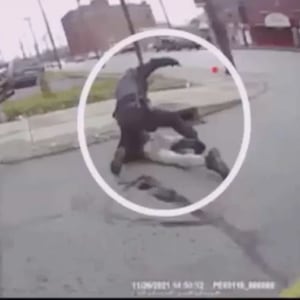Last August, a police officer in Greensboro, North Carolina, gunned down Nasanto Antonio Crenshaw, an unarmed Black teenager, as he allegedly attempted to evade a police stop in a stolen vehicle.
According to a new lawsuit filed on Thursday morning by Crenshaw’s mother, the officer fired two additional shots as the vehicle rolled slowly past him—even though he wasn’t in harm’s way.
“This is a bad shooting,” said lawyer Harry Daniels, who likened the boy’s death to that of Andrew Brown—a Black man shot and killed in his car by police in North Carolina. Daniels represented Brown’s family in a case that settled for $3 million the same summer that Crenshaw died.
ADVERTISEMENT
“Had the video been out there’d [have] been marching protests all over in Guilford county, Greensboro. So this is no different than other ones you see: a Black kid… unarmed, shot and killed by police,” he said. “That's another day in America right now.”
The City of Greensboro referred requests for comment to the police department. Police department spokesperson Josie Cambareri told The Daily Beast in a written statement that since the incident, both state and local authorities have been investigating what happened that day—and that the cop is still on the job.
“As is standard protocol, the officer involved has been on administrative duty since the day of the incident,” wrote Cambareri. “ In addition to the criminal investigation from the [State Bureau of Investigation], GPD does an internal investigation to determine whether or not policies were followed.”
State authorities did not immediately respond to requests on the status of their investigation, or whether it had been submitted to the local District Attorney’s office.
According to the family’s lawsuit, a yet-unnamed police officer responded at 9 p.m. on Aug. 21 to reports of a stolen vehicle on West Market Street. Crenshaw, 17, was later found to be the driver of the car which had multiple passengers, according to the family’s suit.
The officer followed the car to the parking lot of a local business and attempted to block Crenshaw’s vehicle in a dead-end section of the lot. When Crenshaw tried to turn the car, he swiped the front of the officer’s vehicle and stopped in a parking spot.
That’s when the cop exited his vehicle, commanding the group to lie on the ground. That’s also when the situation escalated, the family’s lawsuit claims.
Crenshaw “turned his wheels to the left as he proceeded out of the parking space” in an attempt to evade the policeman and his vehicle, reads the lawsuit, which was based on the family and legal team’s viewing of video footage. Some passengers also bailed out of the car and ran on foot, leaving Crenshaw and another minor alone.

Nasanto Antonio Crenshaw
Courtesy of the Crenshaw familyThen, the cop fired his first shot.
He then fired two more as the car rolled slowly past the officer, the lawsuit claimed.
According to the lawsuit, bullet trajectories allegedly show the cop was standing to the side of the vehicle when he fired all three shots.
Crenshaw’s sister, Nakita, said that the 14-year-old in the car told her that her brother’s “neck was hanging down,” according to reporting by Triad City Beat.
“At no time was the Defendant…in the trajectory path of Nasanto’s moving vehicle,” the lawsuit stated.
At 9:08 p.m., eight minutes after receiving “gunshot wounds to his right forearm, right-side rib cage, and a gunshot wound to the right side of his neck,” Crenshaw died, according to the court filing.
“I feel like you overshot my brother,” Nakita also told Triad City Beat.
According to the Supreme court decision Tennessee vs. Garner deadly force cannot be used on someone who is fleeing unless “the officer has a good-faith belief that the suspect poses a significant threat of death or serious physical injury.”
The lawsuit, filed against the City of Greensboro and the unnamed cop himself, claims that the cop was never in danger and demands compensation for Crenshaw’s loss of life in the latest of questionable shootings of Black men and boys by police—many of which follow a car chase.
While the family initially spoke out after the shooting, Daniels told The Daily Beast that they were forbidden by a court order to tell others what they saw on bodycam footage shown to them in the wake of their son’s death.
“If the police were justified... you and I would have seen that video, same damn day. When it’s something they did wrong they cover it up,” Daniels told The Daily Beast.






